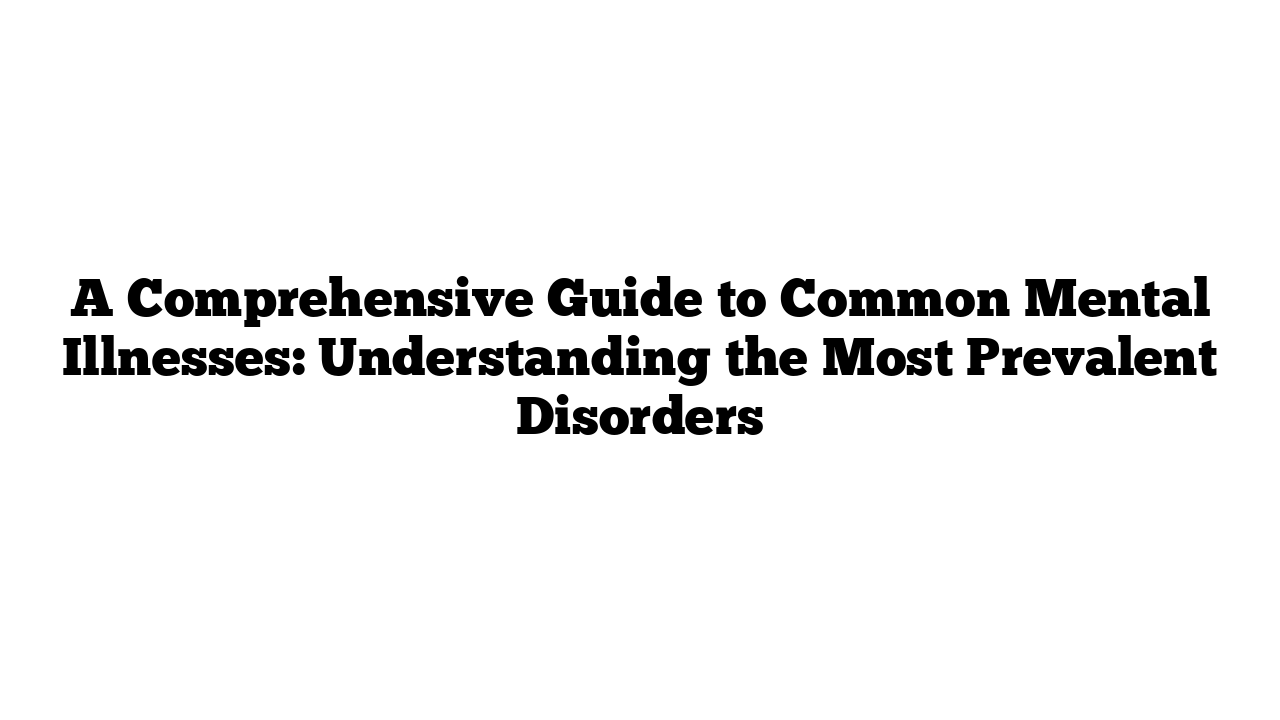Understanding Mental Illness: A Vital Topic for Everyone
Mental illness refers to conditions that significantly impact a person’s thinking, feelings, or mood over an extended period, interfering with their daily life. According to the National Alliance on Mental Illness (NAMI), these conditions can deeply affect relationships, work, and overall quality of life.
Are depression and anxiety considered mental illnesses? The answer is yes, and they are among the most common types. Below, we explore 10 of the most prevalent mental illnesses, shedding light on their symptoms, causes, and available treatments.

1. Anxiety Disorders
Anxiety disorders are the most common mental health issues in the USA, affecting approximately 40 million adults annually, or 18.1% of the population. However, only 36.9% of these individuals seek treatment. Anxiety often appears alongside depression, creating complex challenges for those affected.
Types of Anxiety Disorders Include:
- Generalized Anxiety Disorder (GAD)
- Panic Disorder
- Social Anxiety Disorder (SAD)
- Obsessive-Compulsive Disorder (OCD)
These conditions share a common thread: persistent, uncontrollable worry that disrupts daily life, including work, sleep, and relationships.
Treatment Options:
Effective treatments include therapy (CBT or exposure therapy), medications, and stress management techniques.
2. Personality Disorders
Personality disorders involve deeply ingrained patterns of emotions, thoughts, and behaviors that deviate from societal expectations, causing distress in personal and social interactions.
Prevalence in the USA:
Approximately 9.1% of the population exhibits traits of personality disorders.
Key Features Include:
- Distorted self-perception
- Emotional dysregulation
- Impaired impulse control
While personality disorders cannot be cured, psychotherapy and targeted medications can help manage symptoms effectively.
3. Attention-Deficit/Hyperactivity Disorder (ADHD)
ADHD isn’t just a childhood issue—adults experience it too. In the USA, between 7.8% and 11% of children aged 4–17 are diagnosed annually.
Common Symptoms Include:
- Difficulty concentrating
- Restlessness
- Forgetfulness
- Losing items frequently
Treatment Approaches:
Behavioral therapy, life coaching, and medications are commonly combined to provide relief.
4. Post-Traumatic Stress Disorder (PTSD)
Approximately 6.8% of Americans will experience PTSD at some point, often following traumatic events such as natural disasters, assault, or abuse.
Symptoms Include:
- Emotional flashbacks
- Nightmares
- Extreme anxiety
Therapies such as EMDR (Eye Movement Desensitization Reprocessing) and CBT offer relief by helping the brain process trauma more effectively.
5. Depression
Depression affects 6.7% of Americans over 18, or 15.7 million people annually. Unlike occasional sadness, depression involves prolonged feelings of worthlessness or fatigue lasting more than six weeks.
Gender Differences:
- Women: Feelings of sadness, guilt, and worthlessness dominate.
- Men: Fatigue and irritability are more common.
Treatment Options:
Therapies like CBT, IPT (Interpersonal Therapy), and antidepressants are widely used.
6. Bipolar Disorder
Bipolar disorder is often misunderstood as simple mood swings, but it involves severe emotional highs (mania) and lows (depression).
Prevalence:
Around 2.8% of Americans received a diagnosis in recent years.
Treatment Options:
A combination of mood stabilizers, therapy, and lifestyle adjustments can help individuals maintain stability.
7. Eating Disorders
Eating disorders affect 2.7% of Americans seeking treatment and are marked by extreme dissatisfaction with body image.
Types Include:
- Anorexia Nervosa
- Bulimia
- Avoidant Restrictive Food Intake Disorder (ARFID)
Recovery:
With residential programs, talk therapy, and nutritional counseling, full recovery is possible.
8. Obsessive-Compulsive Disorder (OCD)
OCD is an anxiety-related disorder, with 2.3% of Americans meeting diagnostic criteria at some point.
Symptoms Include:
- Obsessions: Intrusive thoughts about cleanliness, order, or morality.
- Compulsions: Repetitive actions like handwashing or counting.
Treatment Approaches:
CBT and medication are essential tools in managing OCD symptoms.
9. Autism Spectrum Disorder (ASD)
Autism affects about 1 in 59 children in the USA. It’s a developmental condition that impacts communication, learning, and social interaction.
Characteristics:
- Poor eye contact
- Repetitive behaviors
- Difficulty understanding social cues
Intervention:
Early behavioral therapy, speech therapy, and occupational therapy are beneficial.
10. Schizophrenia and Psychotic Disorders
Schizophrenia is a psychotic disorder, with 1% of the population experiencing symptoms. These may include hallucinations, paranoia, and disorganized thinking.
Treatment Includes:
- Antipsychotic medications
- Therapy and community support programs
Hope and Help Are Always Available
Mental health challenges are more common than we think, but help is available through therapy, medications, and support systems. If you or a loved one is facing any of these conditions, reach out to a healthcare professional or visit medicaltimes.io for trusted information.
Reference Websites:
Top 10 FAQs about Mental Illness
- What is mental illness?
Mental illness refers to conditions affecting thoughts, emotions, or behaviors that interfere with daily life. - How common is anxiety in the USA?
Anxiety disorders affect 40 million adults yearly. - Can personality disorders be cured?
They can’t be cured but are manageable with therapy and medications. - What are the symptoms of ADHD?
Common symptoms include inattentiveness, restlessness, and forgetfulness. - How is PTSD treated?
Therapies like EMDR and CBT are highly effective. - What is bipolar disorder?
It involves mood swings ranging from extreme highs (mania) to lows (depression). - Can eating disorders be overcome?
Yes, with a combination of therapy and support, recovery is possible. - What causes OCD?
OCD often stems from anxiety, characterized by intrusive thoughts and compulsive actions. - What are the signs of ASD?
Difficulty with social interactions, repetitive behaviors, and restricted interests are key signs. - Is schizophrenia treatable?
Yes, antipsychotics and therapy can greatly improve the quality of life for those affected.
